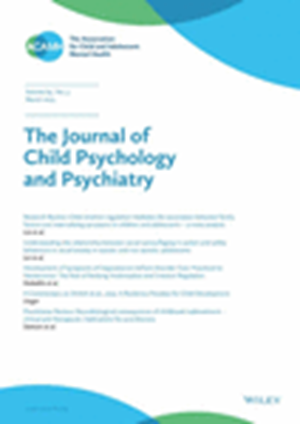利用网络分析绘制青少年易怒、抑郁和ADHD之间的表型和遗传关系。
IF 7
1区 医学
Q1 PSYCHIATRY
引用次数: 0
摘要
背景:可逆性是儿童和青少年心理健康服务转诊的常见原因。然而,关于易怒是最好的概念化和治疗作为情绪障碍的特征,对立违抗性障碍或ADHD的核心症状存在争议。方法采用网络分析方法,利用雅芳父母与儿童纵向研究(ALSPAC),研究青少年易怒、任性/伤害性ODD项目、抑郁和ADHD表型以及抑郁和ADHD多基因评分(PGS)之间的关系。在初步分析中,易怒、抑郁、任性/伤害性ODD项目和ADHD在15岁时使用发展和幸福评估(DAWBA)进行定义。在二级分析中,使用13岁时的短期情绪和感觉问卷(SMFQ)和优势和困难问卷(SDQ) ADHD和行为量表来定义表型。最后,我们在千年队列研究(MCS)中使用验证性网络分析测试了网络的可复制性。结果在ALSPAC中使用DAWBA的网络分析结果表明,易怒与任性/伤害性ODD项目的相关性最强,其次是ADHD和抑郁。当包括PGS时,我们观察到易怒和抑郁PGS之间存在优势,但易怒和ADHD PGS之间没有优势。易怒似乎是ADHD和抑郁之间的主要途径,也是任性/伤害性ODD和抑郁之间的主要途径。在ALSPAC中使用SMFQ/SDQ结果相似,验证性网络分析表明MCS模型拟合良好。结论虽然易怒似乎是跨诊断的,但在表型上,它与任性/伤害性ODD项目和更广泛的行为问题密切相关,这有利于ICD-11将易怒作为ODD的一个具体指标。然而,易怒似乎是ADHD和行为问题与抑郁症之间的关键联系;因此,监测和治疗患有多动症或行为问题的青少年是很重要的。本文章由计算机程序翻译,如有差异,请以英文原文为准。
Mapping phenotypic and genetic relationships among irritability, depression and ADHD in adolescence using network analysis.
BACKGROUND
Irritability is a common reason for referral to child and adolescent mental health services. However, debate exists as to whether irritability is best conceptualised and treated as a feature of mood disorder, oppositional defiant disorder or a core symptom of ADHD.
METHODS
We use network analyses to examine the relationships between adolescent irritability, headstrong/hurtful ODD items, depression and ADHD phenotypes, and polygenic scores (PGS) for depression and ADHD using the Avon Longitudinal Study of Parents and Children (ALSPAC). In primary analysis, irritability, depression, headstrong/hurtful ODD items and ADHD were defined using the Development and Well-Being Assessment (DAWBA) at age 15. In secondary analysis, phenotypes were defined using the Short Mood and Feelings Questionnaire (SMFQ) and the Strengths and Difficulties Questionnaire (SDQ) ADHD and behavioural subscales at age 13. Finally, we tested for network replicability using confirmatory network analysis in the Millennium Cohort Study (MCS).
RESULTS
Results of network analyses using the DAWBA in ALSPAC indicated irritability was most strongly associated with headstrong/hurtful ODD items, followed by ADHD and depression. When including PGS, we observed an edge between irritability and depression PGS but not between irritability and ADHD PGS. Irritability appeared to be the primary pathway between ADHD and depression as well as between headstrong/hurtful ODD items and depression. Results were similar using SMFQ/SDQ in ALSPAC and confirmatory network analysis indicated excellent model fit in MCS.
CONCLUSIONS
Although irritability appears to be transdiagnostic, phenotypically, it was most strongly associated with headstrong/hurtful ODD items and broader behavioural problems, which favours the ICD-11 approach of including irritability as a specifier of ODD. However, irritability appeared to be a key connector between both ADHD and behavioural problems to depression; thus, is important to monitor and treat in affected youth with ADHD or behavioural problems.
求助全文
通过发布文献求助,成功后即可免费获取论文全文。
去求助
来源期刊
CiteScore
13.80
自引率
5.30%
发文量
169
审稿时长
1 months
期刊介绍:
The Journal of Child Psychology and Psychiatry (JCPP) is a highly regarded international publication that focuses on the fields of child and adolescent psychology and psychiatry. It is recognized for publishing top-tier, clinically relevant research across various disciplines related to these areas. JCPP has a broad global readership and covers a diverse range of topics, including:
Epidemiology: Studies on the prevalence and distribution of mental health issues in children and adolescents.
Diagnosis: Research on the identification and classification of childhood disorders.
Treatments: Psychotherapeutic and psychopharmacological interventions for child and adolescent mental health.
Behavior and Cognition: Studies on the behavioral and cognitive aspects of childhood disorders.
Neuroscience and Neurobiology: Research on the neural and biological underpinnings of child mental health.
Genetics: Genetic factors contributing to the development of childhood disorders.
JCPP serves as a platform for integrating empirical research, clinical studies, and high-quality reviews from diverse perspectives, theoretical viewpoints, and disciplines. This interdisciplinary approach is a key feature of the journal, as it fosters a comprehensive understanding of child and adolescent mental health.
The Journal of Child Psychology and Psychiatry is published 12 times a year and is affiliated with the Association for Child and Adolescent Mental Health (ACAMH), which supports the journal's mission to advance knowledge and practice in the field of child and adolescent mental health.

 求助内容:
求助内容: 应助结果提醒方式:
应助结果提醒方式:


